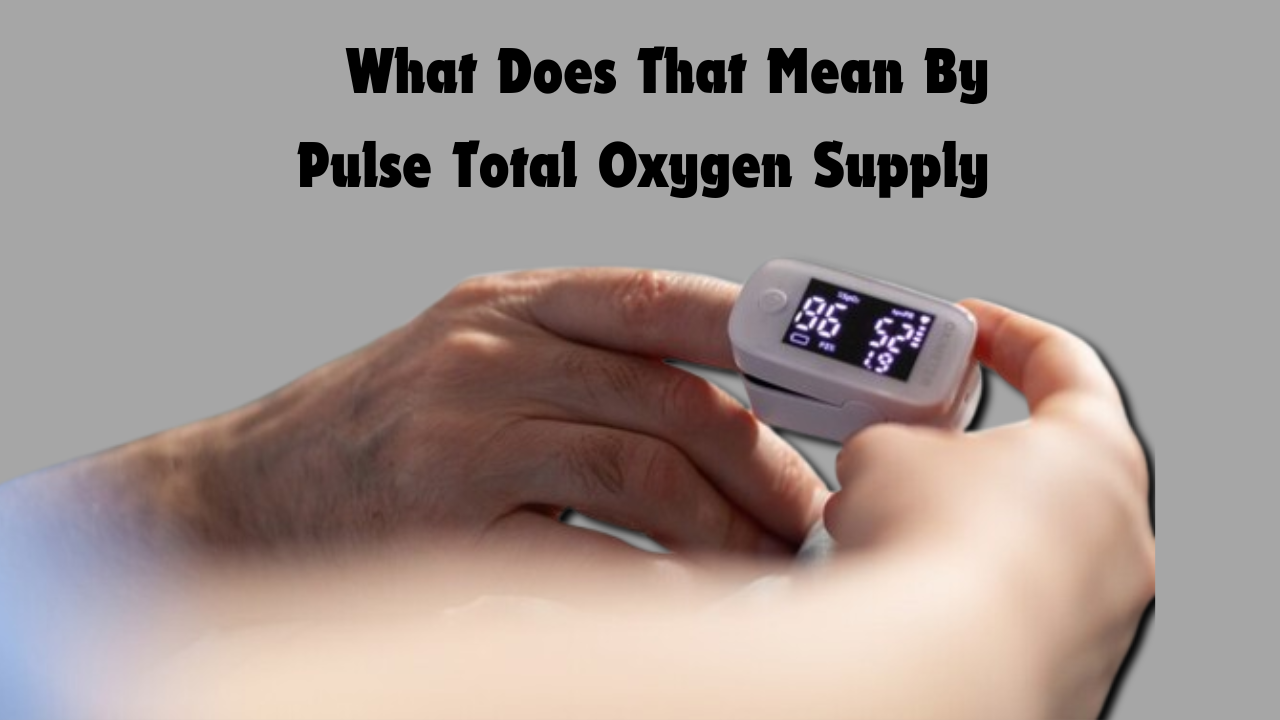Oxygen is crucial for the body’s cellular functions, and monitoring how much oxygen is present in the body is essential for maintaining health. One term that often comes up in medical and wellness discussions is “pulse total oxygen supply.” This article explores what this term means, how it is measured, and its significance in healthcare and fitness.
Oxygen is one of the most essential elements of human life. It fuels the body’s cells, keeps organs functioning, and helps maintain overall health. One commonly heard term in the medical field is pulse total oxygen supply, but many people may not know what it means or why it’s important. This article will break down the concept of pulse total oxygen supply, how it’s measured, and its relevance in healthcare and fitness.
Understanding Oxygen Supply in the Body
Oxygen supply in the body refers to the amount of oxygen available in the bloodstream to be delivered to various tissues and organs. Every cell in your body needs oxygen to function properly. The body inhales oxygen through the lungs, which is then carried by the bloodstream to organs and tissues.
The oxygen supply is crucial for several processes, including:
- Cellular respiration, where cells convert oxygen into energy.
- Maintaining proper brain and heart function.
- Supporting muscle activity, especially during physical exertion.
If the body doesn’t get enough oxygen, it can lead to hypoxia, a condition where tissues become oxygen-deprived, leading to fatigue, confusion, or more severe health issues.
What is Pulse Total Oxygen Supply?
Pulse total oxygen supply refers to the combination of oxygen saturation in the blood and pulse rate. It’s essentially a measure of how much oxygen is circulating through the body at a given moment, based on how efficiently the heart is pumping oxygenated blood. This measurement gives an insight into how well your body is delivering oxygen to vital organs and tissues.
Difference Between Pulse Total Oxygen and Other Oxygen Metrics
While pulse total oxygen supply combines pulse rate and oxygen saturation, other oxygen metrics like SpO2 (peripheral oxygen saturation) or VO2 max focus on specific aspects of oxygen in the body. Pulse total oxygen offers a broader understanding of your overall oxygen delivery system.
How Pulse Total Oxygen is Measured
The most common device used to measure oxygen levels is a pulse oximeter. This small, non-invasive device clips onto your finger, measuring both your pulse rate and oxygen saturation (SpO2).
- Pulse Rate: The number of heartbeats per minute. It indicates how fast your heart is pumping blood.
- Oxygen Saturation (SpO2): The percentage of oxygen-bound hemoglobin in the blood. This shows how much oxygen your red blood cells are carrying relative to their total capacity.
The combination of these two readings gives healthcare providers and individuals a quick snapshot of oxygen supply in the body.
Components of Pulse Total Oxygen Supply
The key factors that contribute to pulse total oxygen supply include:
- Pulse Rate: This is the number of times your heart beats per minute. A faster pulse rate indicates that your body is working harder to deliver oxygen to tissues.
- Oxygen Saturation (SpO2): Measured as a percentage, SpO2 shows how much oxygen is carried by red blood cells. A normal SpO2 level typically ranges between 95% and 100%.
- Hemoglobin Levels: While not measured directly by a pulse oximeter, the amount of hemoglobin in your blood can impact your overall oxygen supply since hemoglobin is responsible for carrying oxygen.
Normal Range for Pulse Total Oxygen Supply
For most healthy individuals, an oxygen saturation level (SpO2) between 95% and 100% is considered normal. The resting pulse rate typically falls between 60 and 100 beats per minute (bpm).
Athletes or individuals in top physical condition may have lower resting pulse rates (as low as 40 bpm) because their hearts are more efficient at pumping blood. However, their SpO2 levels should still remain in the normal range.
Factors That Influence Pulse Total Oxygen Supply
Several factors can influence an individual’s pulse total oxygen supply:
- Physical Activity: During exercise, the body demands more oxygen, which increases both pulse rate and oxygen consumption. Monitoring this can help optimize performance.
- Medical Conditions: Chronic conditions like asthma, chronic obstructive pulmonary disease (COPD), or anemia can reduce oxygen levels, requiring closer monitoring of pulse total oxygen supply.
- Environment: High altitudes have lower oxygen levels, which can reduce oxygen saturation. People traveling to or living in these areas may notice changes in their oxygen readings.
The Importance of Monitoring Pulse Total Oxygen Supply
Monitoring pulse total oxygensupply is critical for people with certain health conditions, athletes, or those recovering from illness. Knowing your body’s oxygen levels can help you avoid serious health complications like hypoxia, where your body tissues don’t receive enough oxygen.
How Pulse Total Oxygen Supply is Used in Healthcare
In healthcare settings, pulse total oxygensupply is used to monitor patients with conditions that affect their breathing or cardiovascular function. It’s particularly important in:
- Emergency Care: During medical emergencies like heart attacks or strokes, maintaining oxygen supply is critical.
- Surgery and Post-Operative Care: Oxygen levels are monitored closely during and after surgery to ensure the body’s organs are receiving adequate oxygen.
- Chronic Disease Management: Patients with lung or heart diseases may need to regularly check their oxygen levels to manage their conditions effectively.
Pulse Total Oxygen in Fitness and Sports
Athletes and fitness enthusiasts also monitor their oxygen supply to track performance. By measuring oxygen during workouts, individuals can assess how efficiently their body is using oxygen, optimize training regimens, and track recovery.
Low Pulse Total Oxygen Supply: Causes and Symptoms
When pulse total oxygensupply drops below normal levels, it can result in symptoms such as:
- Shortness of breath
- Fatigue or weakness
- Rapid heart rate
- Dizziness or confusion
Conditions that might cause low oxygen supply include respiratory diseases, heart failure, or blockages in the airways.
Treatment for Low Oxygen Supply
For individuals with low oxygen levels, treatment options include:
- Oxygen Therapy: Delivering extra oxygen through a mask or nasal cannula.
- Lifestyle Changes: Quitting smoking, regular exercise, and improving diet can enhance the body’s oxygen utilization.
Technological Advances in Monitoring Oxygen Supply
Recent advances in technology have made it easier for individuals to monitor their oxygen levels at home. Wearable devices like fitness trackers and smartwatches now often include pulse oximeters, making it easier to monitor pulse total oxygensupply during daily activities or workouts.
Common Misconceptions About Pulse Total Oxygen Supply
One common misconception is that having a high pulse total oxygensupply automatically means you’re in perfect health. However, factors like heart health, lung function, and overall fitness also play key roles in determining your body’s oxygen delivery capabilities.
Conclusion
Understanding pulse total oxygen supply is essential for maintaining good health, whether you’re an athlete looking to optimize performance or someone managing a chronic illness. Monitoring your oxygen levels gives you critical insights into how well your body is functioning, and it helps detect potential problems before they become serious.
FAQs
- What is pulse total oxygen supply?
Pulse total oxygensupply refers to the combined measurement of pulse rate and oxygen saturation, indicating how efficiently your body is delivering oxygen to its tissues. - What are normal oxygen levels?
A normal SpO2 level is between 95% and 100%, while a normal pulse rate ranges from 60 to 100 bpm, depending on activity and health status. - How can I monitor my pulse total oxygen supply?
Pulse oximeters or wearable devices that measure both heart rate and oxygen saturation are commonly used to monitor oxygen levels. - What are the symptoms of low oxygen supply?
Symptoms include shortness of breath, fatigue, rapid heart rate, and confusion, often requiring medical attention. - Why is it important to monitor oxygen levels during exercise?
Monitoring your oxygen levels during workouts helps ensure your body is efficiently using oxygen and prevents overexertion.














